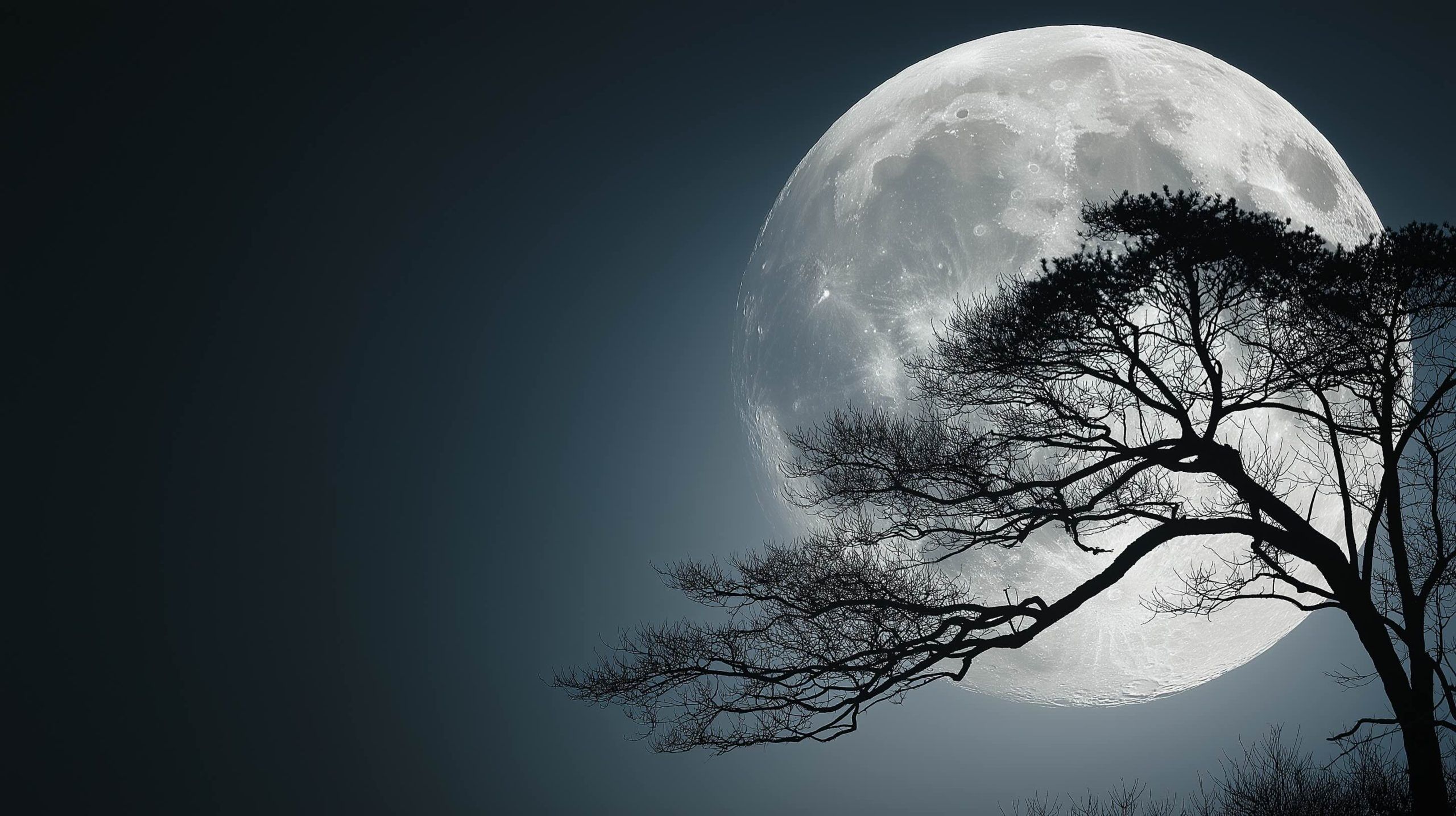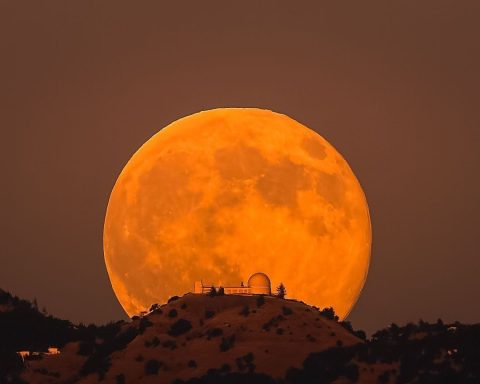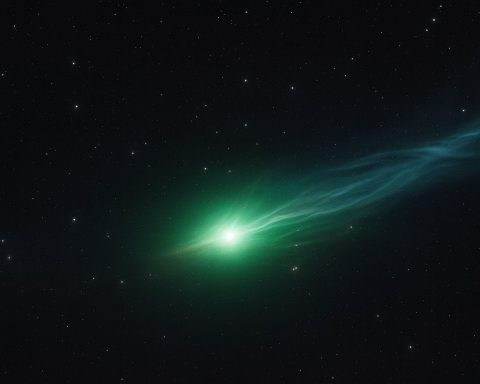- The October 6, 2025 full Moon peaks at 11:48 p.m. Eastern Time (03:48 UTC on October 7).
- It is a supermoon near perigee, about 6–7% larger and 13% brighter than a typical full Moon, and the first full supermoon of 2025.
- The Moon will be visible from anywhere it’s nighttime, with no special location required for viewing.
- The Moon’s disk will be 100% illuminated, appearing as a perfect luminous circle, with a near-full phase from October 5–7.
- Saturn will lie about 3°–4° from the Moon around October 6–7, with magnitude 0.6, visible near Pisces.
- This October 2025 full Moon is the first of a trio of back-to-back year-end supermoons in October, November, and December 2025.
- There is no lunar eclipse in October 2025, as it falls outside the eclipse season.
- Traditionally this Moon is known as the Hunter’s Moon, and because it is near the autumn equinox it is also considered the Harvest Moon for 2025.
- The Draconid meteor shower peaks around October 8, 2025, but the near-full Moon will wash out most meteors.
- Indigenous names for the October Moon include Falling Leaves Moon (northeastern tribes), Someone Stores Food Moon (Oneida), and When They Store Food in Caches Moon (Ponca).
When and Where to See the October 2025 Full Moon
Mark your calendars: the full moon of October 2025 occurs on Monday, October 6, 2025, reaching peak illumination at 11:48 p.m. Eastern Time, which is 03:48 UTC on October 7 [1]. In practical terms, that means skywatchers in the Americas will see the moon at its fullest on the night of October 6, while in Europe and Africa it arrives in the predawn hours of October 7. For those in Asia and Oceania, the moment of peak fullness falls during daylight, so the moon will appear essentially just as full on the nights immediately before or after this time. The good news is you don’t have to pinpoint the exact minute – according to NASA, the moon will appear virtually full for about three days around the peak [2]. In fact, any clear evening around early October 6–7 will treat you to a big bright moonrise around sunset and a golden orb shining all night long. As NASA notes, a full Moon rises at sunset and soars high at midnight [3], meaning wherever you are, you’ll have bright moonlight from dusk till dawn during this event (weather permitting!).
Importantly, everyone around the world gets to enjoy this full moon – it’s visible to any location where it’s nighttime. There is no special location requirement as there would be for an eclipse; if the skies are clear and it’s dark outside, the full moon will be beaming down. In October the moon’s path in the sky is roughly opposite the Sun’s: in the Northern Hemisphere it climbs fairly high through the autumn constellations, while in the Southern Hemisphere it stays somewhat lower. But either way, it will be hard to miss. The moon’s disk will be 100% illuminated, appearing as a perfect luminous circle. If you can’t catch it on the exact date, don’t worry – on the nights of October 5, 6, and 7 the moon will look almost equally full to the casual eye [4]. Just look east around sunset for a massive moonrise, or later at night overhead.
Visibility Tip: Around this time of year, the moon’s trajectory makes it rise sooner after sunset than usual. In fact, on the nights around the full moon, the moonrise is only roughly 20–30 minutes later each day (instead of the typical ~50 minutes) [5]. This means relatively short gaps between sunset and moonrise, creating successive bright evenings. So, if you head outside shortly after sundown on October 6 (or the nearest clear night), you’ll likely see the gigantic moon already peeking above the horizon in twilight, adding an enchanting glow to the early night sky.
A “Supermoon” Celestial Event – Why It’s Special
This isn’t just any full moon – it’s also a supermoon. A supermoon occurs when a full moon coincides with the moon being near its closest point to Earth (perigee) in its slightly oval-shaped orbit [6]. During a supermoon, the moon appears a bit bigger and brighter than average. How much brighter? At its extreme, a full moon at perigee can look up to 14% larger and 30% brighter than a full moon at its farthest point (an “apogee” or micromoon) [7]. In the case of the October 2025 full moon, calculations show it will be about 6–7% larger and 13% brighter than a typical full moon [8] – a noticeable boost, though keep in mind that to our eyes the difference can be subtle.
Because this full moon occurs so near perigee, it earns the popular title of “Super Hunter’s Moon.” In fact, October 2025’s full moon is the first full supermoon of the entire year 2025 [9] [10]. (There were no supermoon full moons in the earlier months of 2025, so skywatchers have been waiting for this!) It also kicks off a trio of consecutive year-end supermoons, with three back-to-back full supermoons in October, November, and December 2025 [11]. That means the Moon will be notably close and bright for the last quarter of the year. Of these, November’s full moon will be the very closest of 2025 (the absolute “biggest” supermoon) [12], but only by a small margin. In fact, astronomers emphasize that even the brightest supermoon is only slightly brighter than a normal full moon – one NASA expert noted it’s the “brightest, but only by a tiny margin” compared to others [13]. In other words, don’t expect the Moon to look gigantic, but do enjoy the extra brilliance and clarity of moonlight that a supermoon provides.
From a scientific perspective, a supermoon’s closeness does have a few minor effects. One is higher tides: when the Moon is nearer to Earth, its gravity pulls a bit more strongly on our oceans. This can lead to slightly larger-than-normal tides (often called “perigean spring tides” or informally king tides) in the days around the supermoon [14]. Coastal communities sometimes watch for small tidal flooding during these events, but for most areas it’s not dramatically different – just an extra high high-tide and a lower low-tide. Another effect is purely visual delight: the moonlight during a supermoon can appear crisper, and if you catch the moon rising against the horizon, the combination of the moon illusion and the supermoon’s actual size can be breathtaking. (The “moon illusion” is a trick of our brains that makes the low-hanging full moon look enormous near the horizon [15].) Many people report that a supermoon seems especially picturesque, and it’s a perfect time for both casual stargazers and photographers to enjoy our celestial neighbor. As EarthSky, a popular astronomy outlet, points out, even if the size difference isn’t huge, supermoons definitely appear a bit brighter than ordinary full moons [16] – lending a silvery brilliance to the landscape on a clear night.
One more treat: on the night of this full moon, Saturn will be shining nearby. The Moon will be in the constellation Pisces, and around October 6–7 it passes close to the planet Saturn in the sky. In fact, on the evening of October 6, the 98%-illuminated moon sits only about 3°–4° away from Saturn (magnitude 0.6) on the dome of the sky [17]. That’s roughly a few finger-widths apart at arm’s length. Saturn will appear as a moderately bright, steady golden point above or next to the moon. You won’t need any special equipment to spot it – just look for the bright “star” near the nearly full moon. (If you have a small telescope or even good binoculars, this is a great chance to swing over to Saturn and maybe catch a glimpse of its rings.) Having the moon and Saturn so close together is a nice bonus for skywatchers, and it adds to the celestial spectacle of the night.
Finally, it’s worth noting what will not happen during this full moon: there is no lunar eclipse in October 2025. The previous full moon in September 2025 was a dramatic total lunar eclipse (a “Blood Moon” eclipse) [18], but October’s moon arrives outside of the eclipse season. So the moon will not turn copper-red this time – it will shine brightly all night long. (The next lunar eclipse after September will be in 2026, so this Hunter’s Moon will keep its normal pearly-white glow.) In summary, October’s full moon should be a brilliant, clear supermoon gracing the sky, with no dimming or weird coloration – a perfect opportunity to bask in simple moonlight.
The Hunter’s Moon: Name, Folklore, and Cultural Significance
October’s full moon carries a special place in traditional lore. It is most widely known as the Hunter’s Moon, a name with deep historical roots. According to the Farmer’s Almanac, the term “Hunter’s Moon” first appeared in English writings in the early 18th century (around 1710) [19]. The name makes intuitive sense: this was the time of year when hunters would stock up on game for the winter ahead. After the harvest season ended, game animals like deer and birds would be plump from feeding on the fallen grains and crops, and with fields cleared of crops, hunters had more visibility to track prey by the autumn moonlight [20]. In an era before modern lighting, a bright full moon in October provided vital extra hours to hunt and preserve meat for the lean winter months. As one historian noted, “animals are traditionally hunted in mid- to late autumn when they’ve fattened up… cooler temperatures also made it easier to preserve meat for winter” [21]. The Hunter’s Moon thus signified a last abundance of wildlife and a time to prepare for winter’s scarcity.
In many Native American cultures and other folklore traditions, October’s moon also earned names reflecting the season’s activities and changes. For instance, several northeastern Native American tribes referred to this full moon as the “Falling Leaves Moon,” evoking the defining image of autumn forests shedding their leaves [22]. The Oneida people have called it the “Someone Stores Food Moon,” a reminder of caching supplies for winter [23]. In the Great Plains, the Ponca tribe used a name that translates roughly to “When They Store Food in Caches Moon,” similarly highlighting the importance of stockpiling for cold weather [24]. All these names are tied to survival in autumn: gathering the harvest, hunting game, and storing provisions.
Even the more commonly known Western term “Harvest Moon” comes into play around this time. Traditionally, the Harvest Moon is the full moon nearest to the autumnal equinox (which fell on September 22, 2025). In most years that’s the September full moon – however, 2025 is an exception. This year October’s full moon is closer to the equinox than the September one, so by the classic definition October 6 is actually the “Harvest Moon” for 2025 [25]. (Such a shift happens about every four or five years [26].) Many sources, including astronomers like Joe Rao, note that in 2025 the usual September Harvest Moon title passes to October’s moon [27]. When this happens, the September moon is sometimes called the Corn Moon instead, and October claims the Harvest Moon name [28]. However, culturally a lot of people simply stick with calling the October moon the Hunter’s Moon, since it comes after the harvest time. Both names are rich in meaning: the Harvest Moon is famous for rising soon after sunset for several evenings in a row, giving farmers extra light to bring in crops [29], while the Hunter’s Moon extends that gift of light into the next month for hunters. In essence, they are two back-to-back full moons that for centuries have been associated with the agricultural cycle: first gather the crops, then hunt the game.
Interestingly, you may also hear the October full moon referred to as a “Blood Moon” in some folklore. In Pagan and medieval English traditions, October’s moon was sometimes called the Blood Moon or Sanguine Moon – not for its color, but symbolically for the hunting season’s bloodshed (and perhaps the reddish hue of autumn leaves) [30]. This old usage is not to be confused with the modern media term “Blood Moon” meaning a total lunar eclipse. In fact, NASA’s lunar expert Gordon Johnston explains that while today Blood Moon often describes an eclipse’s red shadow, it “is also an alternate name for full moons that happen in autumn, commonly known as the Hunter’s Moon or Harvest Moon.” [31] So if you see “Blood Moon” mentioned for October, it might be referencing this traditional name. (Rest assured, October 2025’s moon will not actually turn blood-red – again, no eclipse this time – it’s just a historical name in this context.)
The Hunter’s Moon has an aura of lore and legend around it. It heralds a change in seasons: in the Northern Hemisphere, October’s moon illuminates crisp fall nights, lively with the activity of migrating animals and rustling leaves. In folklore, some even considered the Hunter’s Moon a bit of a “bonus” full moon – extra light after the Harvest Moon, helping communities finish up autumn tasks. Unlike many full moon names that are tied to one month, the Harvest and Hunter’s Moons are unique because they are defined by the season (equinox timing) rather than a specific month [32]. This made them widely recognized across Europe and North America. Even today, the term Hunter’s Moon is frequently used in news and culture, evoking imagery of Halloween, autumn harvest festivals, and evenings by the fire. It’s no coincidence that October’s moon often features in spooky lore and literature – shining near Halloween, it’s the last full moon before the dark winter and has a certain mystique. But whether you call it the Hunter’s Moon, Harvest Moon, or something else, this full moon has long been a signal of seasonal transition and human activity in rhythm with nature.
Recent News and Expert Insights
The approach of the October 2025 full moon has been making news in astronomy circles and even popular media. Because it’s a supermoon, many observatories and science communicators are highlighting this event as one of the top night-sky attractions of 2025. In fact, it’s been noted that the previous full supermoon occurred almost a year ago in late 2024, so stargazers are excited for the supermoon “dry spell” to end [33]. NASA and other agencies have been educating the public on what supermoons are – emphasizing that while the term originated in modern folklore, it’s a great way to get people interested in looking up at the sky [34] [35]. Astronomers encourage everyone to go out around October 6–7 to enjoy the view, especially since no telescopes are needed – the moon is bright enough to appreciate even in light-polluted city skies. Just find a spot with a clear view of the east horizon around sunset and watch that pumpkin-orange moon ascends into the sky.
“The Moon will appear full from early Monday to early Thursday…hard to beat as a celestial view,” notes Jamie Carter, a science writer, describing full moons in a skywatching guide [36] [37]. Indeed, the consensus among experts is that this full moon will be a splendid spectacle for casual observers. The combination of a supermoon’s extra brightness and the autumn timing makes it ideal for night hikes, moonlit photography, or just cozy stargazing. Some planetariums and astronomy clubs are likely to host “moon watch” nights on October 6 or 7, where the public can learn fun facts and look through telescopes at lunar craters (when the moon is full, details wash out a bit, but it’s still an impressive sight up close!).
One scientific point experts make is to manage expectations: do not anticipate the moon appearing dramatically larger than normal – the change is noticeable but not mind-blowing. “If you didn’t know it was a supermoon, you might just think it’s a particularly pretty full moon,” one astronomer quipped in a recent interview. That said, many people do report supermoons feel special, perhaps due to their timing or just the power of suggestion. As EarthSky’s editors put it, supermoons aren’t mere hype; they have become popular because they give us a reason to connect with the night sky [38]. There’s a bit of folklore meets astronomy at play – a perfect blend for public interest.
From a cultural standpoint, October 2025’s full moon has also been noted in the calendar of events for the season. It aligns with a number of fall celebrations and traditions. For example, it comes just after the Mid-Autumn Festival period (which was in late September in 2025) and just before many harvest festivals and Halloween. That means this brilliantly lit moon will adorn the skies during outdoor fall activities, from evening football games to late-night corn mazes and hayrides. Farmers and gardeners often pay attention to moon phases, and the Old Farmer’s Almanac cheerfully reminds readers that this “famous Harvest Moon lights up the skies on October 6”, helping to usher in the final harvests of corn, pumpkins, and other autumn produce [39]. The Almanac also mentions that around this moon, “the Moon rises very soon after the Sun sets”, providing a sequence of bright nights ideal for working or celebrating outdoors [40].
Astronomy experts also point out some observational advice: because the moon will be very bright, it can drown out fainter stars. If you’re hoping to do any deep-sky stargazing or catch a meteor shower, the full moon’s glare is a challenge. (In fact, the Draconid meteor shower peaks around October 8, 2025, but this year the nearly full moon will wash out most of those typically sparse meteors.) However, for lunar enthusiasts, the bright moon is the main attraction. With binoculars you can still make out the larger lunar maria (the “seas”) and bright ray craters like Tycho on the moon’s surface. And if you don’t have any equipment, just soaking in the moonlight is rewarding enough. Some photographers use full moons like this to capture creative shots of the moon looming behind landmarks or silhouetted trees (remember to use a tripod and proper settings, as the moon is brighter than your camera thinks!).
In expert commentary, NASA’s veteran lunar tracker Gordon Johnston often provides colorful context in his monthly moon blog. While discussing full moons of autumn, he highlights how terms like Harvest, Hunter’s, and even Blood Moon interrelate. For this month, one of his key points was clarifying the Blood Moon terminology (as mentioned earlier) – illustrating how our language for the moon blends science and folklore [41]. Another expert, Joe Rao (a skywatching columnist and astronomer), emphasizes the unusual timing of 2025’s Harvest vs. Hunter’s Moon situation, explaining that it’s a relatively rare calendar quirk that “shifts to the October full moon every four to five years” [42]. Rao also vividly describes the practical benefit of the Harvest Moon’s light: farmers at the peak of harvest could “work into the night by the light of this moon” [43], and notes the reduced nightly delay in moonrise during this period [44]. Such expert insights remind us that what we’re seeing in the sky has been noticed and used by people for ages. The full moon of October has always been a “working moon” and a “celebrating moon” – lighting the way for final harvests, hunts, and festivals.
In Summary: Enjoy the Show!
All told, the October 2025 full moon promises to be a memorable one. It combines several factors that make it a must-see event: it’s a supermoon (bigger and brighter than usual) [45], it carries the rich legacy of the Hunter’s Moon with centuries of folklore behind it [46], and it will be shining generously on communities worldwide as we usher in the heart of autumn. Around the world, millions of people will look up at the same moon on the same night – a simple experience that connects us across time and culture.
So on the night of October 6, 2025, step outside and soak in the moonlight. Look for Saturn glimmering nearby as a bonus treat [47]. Consider the many names this moon has been given – Harvest Moon, Hunter’s Moon, Blood Moon, Falling Leaves Moon – and what those names meant to people in the past. Feel the bright, cool light that in bygone eras meant extra hours to gather food or track deer by moonrise. And simply enjoy the natural beauty of our cosmic neighbor at its fullest and brightest. Whether you’re an avid astronomer or just a casual moon-gazer, this Super Hunter’s Moon is an event worth stepping out for. Clear skies and happy moon-watching!
Sources:
- NASA – Science News: Explanation of supermoons and full moon timing [48] [49] [50]
- Farmers’ Almanac and Old Farmer’s Almanac: Full moon names, cultural lore, and timing for October 2025’s “Hunter’s Moon” [51] [52] [53]
- Space.com (J. Rao) – Skywatching column on 2025 full moons (Harvest Moon details and timing) [54] [55]
- EarthSky and StarWalk – Supermoon distances, brightness, and 2025 astronomical highlights [56] [57]
- News outlets (Fox Weather, etc.) – Expert commentary from NASA’s Gordon Johnston and others on Hunter’s Moon significance and supermoon effects [58] [59].
References
1. www.space.com, 2. science.nasa.gov, 3. svs.gsfc.nasa.gov, 4. science.nasa.gov, 5. www.space.com, 6. science.nasa.gov, 7. science.nasa.gov, 8. starwalk.space, 9. www.marthastewart.com, 10. www.marthastewart.com, 11. www.marthastewart.com, 12. earthsky.org, 13. www.foxweather.com, 14. science.nasa.gov, 15. www.marthastewart.com, 16. earthsky.org, 17. starwalk.space, 18. www.livescience.com, 19. www.foxweather.com, 20. www.farmersalmanac.com, 21. www.farmersalmanac.com, 22. www.farmersalmanac.com, 23. www.farmersalmanac.com, 24. www.farmersalmanac.com, 25. www.space.com, 26. www.space.com, 27. www.space.com, 28. www.marthastewart.com, 29. www.space.com, 30. www.farmersalmanac.com, 31. kjzz.com, 32. www.foxweather.com, 33. science.nasa.gov, 34. earthsky.org, 35. earthsky.org, 36. www.livescience.com, 37. www.livescience.com, 38. earthsky.org, 39. www.goodhousekeeping.com, 40. www.almanac.com, 41. kjzz.com, 42. www.space.com, 43. www.space.com, 44. www.space.com, 45. starwalk.space, 46. www.farmersalmanac.com, 47. starwalk.space, 48. science.nasa.gov, 49. science.nasa.gov, 50. svs.gsfc.nasa.gov, 51. www.farmersalmanac.com, 52. www.farmersalmanac.com, 53. www.space.com, 54. www.space.com, 55. www.space.com, 56. earthsky.org, 57. starwalk.space, 58. www.foxweather.com, 59. kjzz.com










